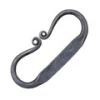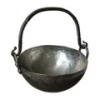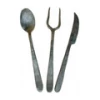
Forged items
You will find a selection of works forged from iron in this category (called Hand-forged products). Many interesting articles are offered to you here. Your attention can attract cutleries, caldrons, scissors, lanterns, fire-steels, old coins replicas or other hand-forged items of applied art. These products are inspired by the ancient and recent history.
Forged items
People have already learned to process iron in the 3rd millennium BC. Forged items intended for the daily needs started to be produced in Asia in the 12th century BC. Iron has all-purpose utilization. Forged railings, gates, furniture, jewelleries, craft tools and weapons - these all are made from iron.
Blacksmiths always used to have a special social status, because they were able to work the fire. People even thought that blacksmiths mastered a kind of magic in the La Tene period. Blacksmithery became a handicraft in the Middle Ages. Blacksmithery reached its height in the baroque period. Baroque artistic blacksmiths excelled especially in France. Beautiful forged decorative elements were created in parks, on balconies, in courtyards. Forged knockers, keys, locks, etc. were made too. Forged items are significant in the Louvre and Versailles.
We would like to offer beautiful hand-forged items of this dying-out craft here. Some forged products are created by Czech blacksmiths, other are imported from abroad. All products have been structured in special categories, like hand-forged fire steels, caldrons and camp tableware, cutleries, candle lanterns, scissors, practical artworks, old coins replicas, strap ends, belt buckles, etc.
Articles

In some situations, disassembling your bow is the most practical solution, especially during maintenance, transport or at the end of the season. This will avoid unnecessary wear and tear of the bow parts. If you are inexperienced in archery,…

The Scouting movement began to form at the beginning of the 20th century. Since then, it had to look for ways to survive during difficult times, such as the world wars and the communist regime in Eastern Europe. Even today, it has to compete for…

Since its foundation in 1943, the Windlass Group has evolved into a diversified group of companies headquartered in Dehradun, Uttarakhand, India. Since then, the group has expanded to almost all parts of the world, manufacturing swords, armour,…

Disassembling a katana isn't difficult, however, it does require precision, and it is advisable to follow safety instructions, and to have a set of necessary tools. Learn how to take apart a Japanese sword and how to put it back together.

A hundred years ago, leather and fur were natural parts of clothing, and very high in demand. But in the last three decades, the leather industry has been going through a rough patch. How have the Czech leatherworking industry and related crafts…

In recent years, the Middle (or Near) East region has been ravaged by conflicts. Unfortunately, this region was never exactly peaceful in the course of history. Let's start in the Old Testament ...

“Wild Fields” refers to the wide expanses of the Ukrainian and South Russian steppes between the rivers Don, Dniester and upper Oka, perhaps as far as the Caspian Sea. This region was barren for a long time. Various raid of nomads and other…

Thousands of years ago, bows were primarily used for hunting. Today, archery has become a hobby and a competitive sport. If our ancestors saw today's bows, they would probably not believe their own eyes! What were bows made of in the past - and…













